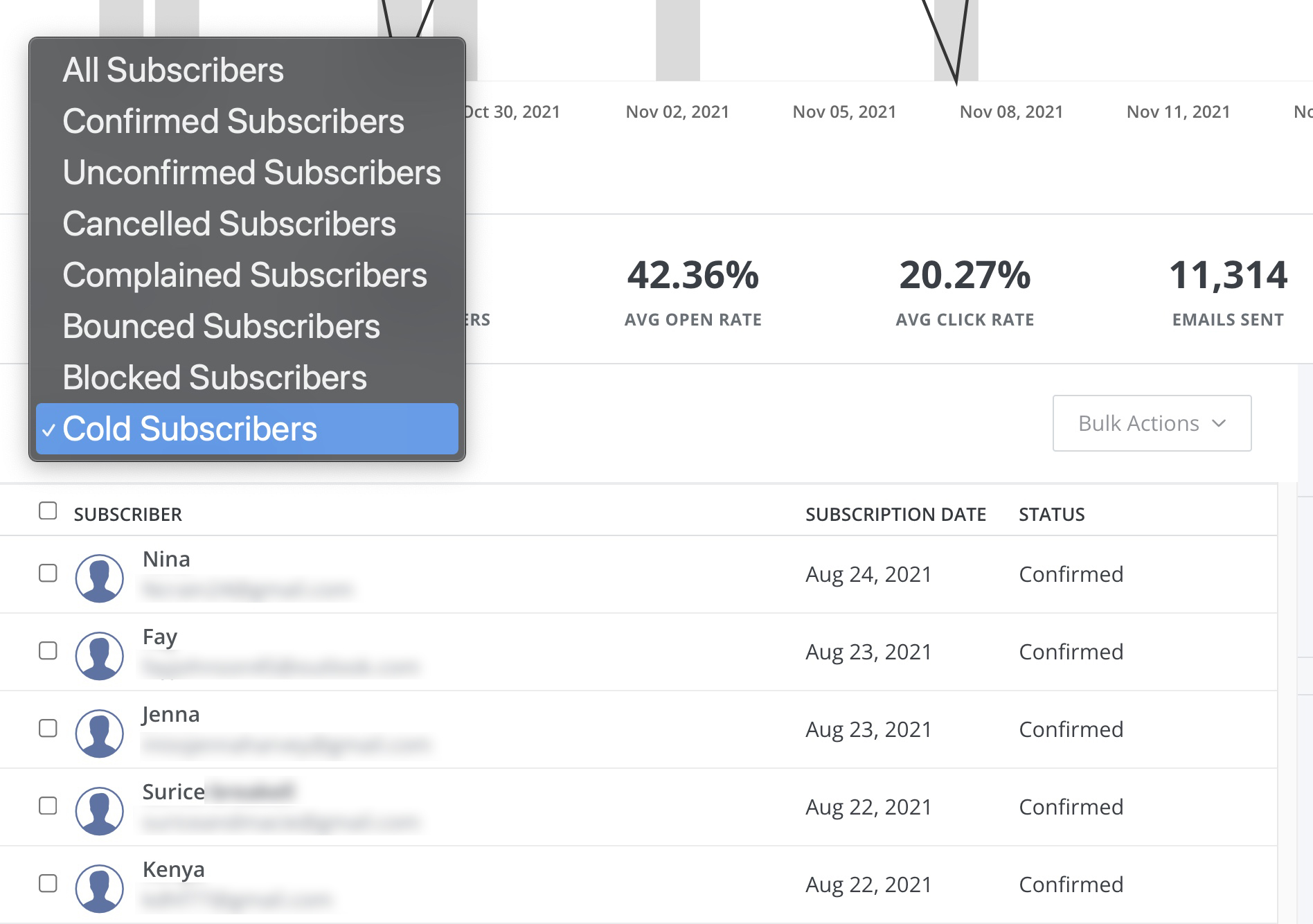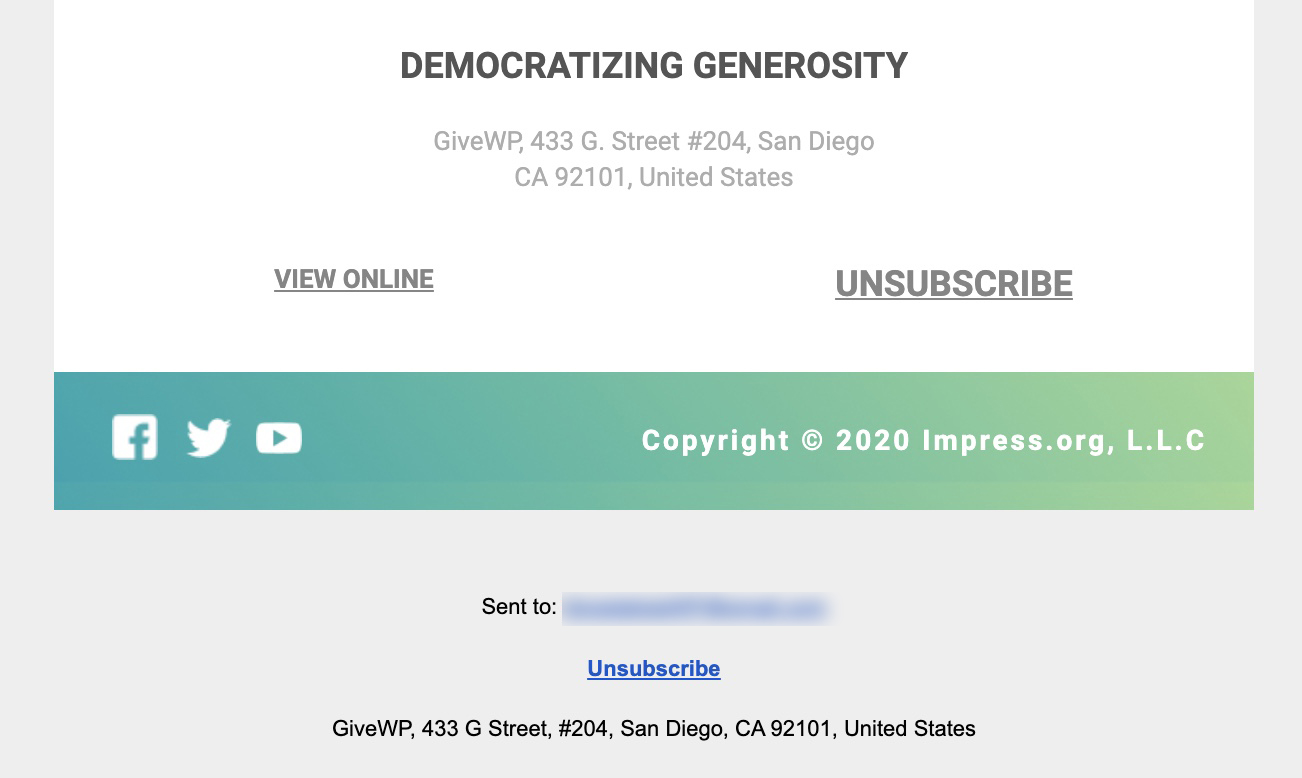A nonprofit newsletter is an excellent way to stay in touch with supporters and boost fundraising efforts. However, due to the many spammers sending emails each day, email service providers (ESPs) have set strict spam filters that could affect your nonprofit’s email deliverability.
Unfortunately, this makes it a bit challenging for good organizations and nonprofits to land on their recipients’ inboxes. On the bright side, there are several steps you can take to improve your nonprofit’s email deliverability — let’s take a look at six of them.
1. Clean up your list
Removing subscribers from your email list might sound terrifying. But removing those who don’t engage with your emails (aka, cold subscribers) brings with it many benefits, including:
- Improved sender reputation. If someone hasn’t opened your emails in several months, chances are they’ll eventually forget even signing up to your list, which will cause them to mark your emails as spam. Removing cold subscribers will allow you to minimize the number of spam complaints.
- Increased open rates. The bigger the list, the more inaccurate email addresses you’ll have (typos by people when subscribing). Removing these addresses will boost your open rates, telling email providers that people are interested in your emails.
- Reduced cost. Many ESPs charge based on how big your list is. Removing cold subscribers will often allow you to reduce costs, leaving you with some budget to spend on other aspects of growing your nonprofit, such as Facebook ads.
The steps to remove cold subscribers will vary depending on your email software. However, many providers offer an option to filter and select cold, or unengaged, subscribers quickly.

One thing to remember before deleting these subscribers is that these providers are not 100% accurate. Therefore, you should email all those subscribers your ESP labeled as “cold,” asking them if they’re still interested in receiving your emails.
Then, you should label or tag (depending on what your ESP uses to organize contacts) those who are still interested and remove them from the “cold subscribers” list.
2. Segment Your List
An effective way to improve your nonprofit’s email deliverability and boost your marketing is by segmenting your list or creating donor personas.
This means that instead of sending the same emails to all your subscribers, you send different emails based on their interests.
For example, let’s say you have a nonprofit that fights climate change. There’s a good chance you’ll have some users interested in volunteering opportunities, others in donating, and a few who only want to learn more about climate change.
Sending constant emails about volunteering opportunities to those who only want to donate and learn more about climate change can eventually cause them to unsubscribe from your list. This might not be because they don’t want to volunteer but because these volunteering opportunities are not near their area of residence — this is especially true if you attract donors from all over the world.
Here are a few ways you can segment your list:
- New subscribers. You can add new subscribers to an email sequence that tells your nonprofit’s story. Showing them your work and the lives you’ve impacted will help them feel more connected to your nonprofit’s mission.
- Engagement rate. Finding the right balance on how many emails to send can be tricky. Send too many, and you risk being labeled a spammer. Send too few, and you risk people forgetting that your nonprofit exists. Segmenting your list by engagement rate can help you give supporters the contact they want—no more, no less. If someone opens all of your emails, you could send them updates more frequently. If someone only opens one email every few months, you could aim to send them only important news.
- Demographics. By segmenting subscribers based on demographics, such as age, gender, geographic location, and industry, you can often relate to them better. For example, if your nonprofit is hosting an in-person fundraising event, you could send those invites only to those close to the event’s location.
- Contributors. Sending updates to contributors is an excellent way to rally support, revitalize your fundraiser, and keep donors in the loop of what has happened since they made their contribution. Additionally, Staying in touch with past contributors is a great way to boost recurring donations.
You can integrate a tool like Airtable with GiveWP to take segmentation a step further. With Airtable, you can gather even more in-depth data about your donors and donations than the fundraising report provided by GiveWP.
For example, you can use Airtable’s data to differentiate between different types of donors, such as lapsed, major, lifetime, and first-time donors, to tailor your fundraising campaigns better.
Amplify your fundraising with a GiveWP Plan
3. Include an Unsubscribe Link
Not only are visible unsubscribe links required to comply with anti-spam laws, but if subscribers have difficulty finding how to unsubscribe from your emails, they’ll go for the next easiest option, marking them as spam.

Most users are familiar with the typical unsubscribe link in the footer of the email. Therefore, you should use the same standard to avoid any confusion.
4. Put a Name Behind Your “From” or “Reply-to” Address
When it comes to emails, you want to let your subscribers and donors know that there’s another person behind the email they just received. Emails can increase engagement, connect with others, and allow them to send comments or ask questions.
A good idea is to put the name of the person in charge of writing your nonprofit’s newsletter or the head of marketing in the “from” or “reply-to” email address and avoid using a “no-reply” address.

Aside from “no-reply” addresses not encouraging conversation, people might not notice it and still write back to you and hit a wall. Spam filters will notice that and suspect your account for being that of a spammer.
5. Limit Spam Trigger Words
Spam trigger words have a bigger effect on for-profit organizations and businesses running sales. However, it’s always a good idea for nonprofits to be aware of some words that can trigger spam filters.
| Order | Online Degree | Credit | Discount |
| Order Status | Opportunity | Earn | Hidden |
| Near you | While you sleep | Acceptance | Home |
| Double your | Affordable | Accordingly | Lifetime |
| Earn $ | Beneficiary | Avoid | Dear |
| Earn extra cash | Cash | Chance | Hello |
| Extra income | Cost | Freedom | Click here |
6. Pay Attention to Your IP Reputation
One of the most important factors in email deliverability is your IP reputation. This reputation is based on multiple factors, some of which you have no control over at all.
For example, one factor is your domain reputation. If you recently launched a nonprofit website, your new domain most likely doesn’t have a track record. This isn’t bad, but it doesn’t help much either. The longer a domain is online, the more authority it can accumulate.
Another important factor is the company/server you choose to send your emails to (aka, your email service provider).
When signing up with an email service provider, users will be put in a shared server with other users and be assigned a group IP address. The downside of this is that if one of your neighbors is sending out spam emails, internet service providers (ISPs) and email clients like Google and Microsoft can blacklist the IP address.
Since everyone on the same server is sharing the same IP address, everyone’s email deliverability will be affected.
That’s why it’s important to choose an ESP that keeps all of its users in check and takes action whenever someone is reported as sending out spam.
Another option is to purchase a dedicated IP for your domain. A dedicated IP is an IP address reserved especially for your domain and nobody else. This exclusivity comes with a higher price tag but will be the best option for big nonprofits.
To check your sender’s reputation, you can use a free tool like MxToolBox.

How is Your Nonprofit’s Email Deliverability Health?
Have you checked your email deliverability rate recently? Email marketing has become critical to fundraising and donor retention for nonprofit organizations. If your emails aren’t landing on your subscribers’ inboxes, you’re losing out on potential donors.
With the strategies mentioned above, you can increase your email deliverability rate and build a more engaging nonprofit organization.


